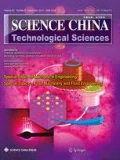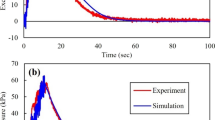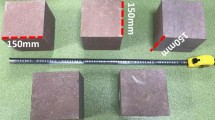Abstract
In this study, a nonlinear model is presented for analysis of damage-cracking behavior in arch dams during strong earthquakes using different seismic input mechanisms. The nonlinear system includes a plastic-damage model for cyclic loading of concrete considering strain softening and a contact boundary model of contraction joint opening. Two different earthquake input mechanisms are used for comparison, including massless foundation input model and viscous-spring boundary model considering radiation damping due to infinite canyon. The results demonstrate that effects of seismic input mechanism and radiation damping on nonlinear response and damage-cracking of the dam are significant. Compared with the results of using massless foundation input model, the damage-cracking region and contraction joint opening are substantially reduced when using viscous-spring boundary model to take into account radiation damping. However, if the damping ratio of the dam is artificially increased to about 10%–15% for massless foundation input model, the joint opening and damage-cracking of the dam are comparable to the results obtained from the viscous-spring boundary model.
Similar content being viewed by others
References
Zhang C H. Challenges of high dam construction to computational mechanics. 6th WCCM, Beijing, 2004
Clough R W. Non-linear mechanisms in the seismic response of arch dams. Proc Int Res Conf Earthquake Eng, Skopje, 1980. 669–684
Fenves G L, Mojtahedi S, Reimer R B. ADAP88: a computer program for nonlinear earthquake analysis of concrete arch dams. Report No. EERC 89-12, Earthquake Engineering Research Center. Berkeley: University of California, 1989
Fenves G L, Mojtahedi S, Reimer R B. Effect of contraction joints on earthquake response of an arch dam. J Struct Eng (ASCE), 1992, 118(4): 1039–1055
Zhang C H, Xu Y J, Jin F. Effects of Soil-Structure Interaction on Nonlinear Response of Arch Dams. Beijing: International Academic Publishers, 1997. 95–114
Zhang C H, Xu Y J, Wang G L, et al. Non-linear seismic response of arch dams with contraction joint opening and joint reinforcements. Earthq Eng Struct Dyn, 2000, 29(7): 1547–1566
Chen H Q. Model test and program verification on dynamic behavior of arch dam with contraction joints. Report No. SVL-94/2 IWHR, 1994
Lin G, Hu Z Q. Earthquake safety assessment of concrete arch and gravity dams. Earthq Eng Eng Vibration, 2005, 4(2): 251–264
Du X L, Tu J. Nonlinear seismic response analysis of arch damfoundation systems-part II opening and closing contact joints. Bull Earthq Eng, 2007, 5(1): 121–133
Ayari M L, Saouma V E. A fracture mechanics based seismic analysis of concrete gravity dams using discrete cracks. Eng Fract Mech, 1990, 35(3): 587–598
Pekau O A, Zhang C H, Feng L M. Seismic fracture analysis of concrete gravity dams. Earthq Eng Struct Dyn, 1991, 20(2): 335–354
El-Aidi B, Hall J F. Nonlinear earthquake response of concrete gravity dams, part I: modeling. Earthq Eng Struct Dyn, 1989, 18(4): 837–851
Bazant Z P, Oh B H. Crack band theory for fracture of concrete. Mat Struct, 1983, 16(93): 155–177
Bhattacharjee S S, Leger P. Seismic cracking and energy dissipation in concrete gravity dams. Earthq Eng Struct Dyn, 1993, 22(4): 991–1007
Wang G L, Pekau O A, Zhang C H, et al. Seismic fracture analysis of concrete gravity dams based on nonlinear fracture mechanics. Eng Fract Mech, 2000, 65(1): 67–87
Cervera M, Oliver J, Faria R. Seismic evaluation of concrete dams via continuum damage models. Earthq Eng Struct Dyn, 1995, 24(6): 1225–1245
Lubliner J, Oliver J, Oller S, et al. A plastic-damage model for concrete. Int J Solids Struct, 1989, 25(3): 299–326
Lee J, Fenves L G. Plastic-damage model for cyclic loading of concrete structures. J Eng Mech (ASCE), 1998, 124(3): 892–900
Lee J, Fenves L G. A plastic-damage concrete model for earthquake analysis of dams. Earthquake Eng Struct Dyn, 1998, 27(9): 937–956
Lysmer J, Kuhlemeyer R L. Finite dynamic model for infinite media. J Eng Mech Division (ASCE), 1969, 95(3): 759–877
Liao Z P, Wong H L, Yang B P, et al. A transmitting boundary for transient wave analyses. Scientia Sinica (Ser A), 1984, 27(10): 1063–1076
Deeks A J, Randolph M F. Axisymmetric time-domain transmitting boundary. J Eng Mech (ASCE), 1994, 120(1): 25–42
Liu J B, Lu Y D. A direct method for analysis of dynamic soil- structure interaction based on interface idea. In: Zhang C H, Wolf J P, eds. Dynamic Soil-Structure Interaction—Current Research in China and Switzerland. Beijing: International Academic Publishers, 1997. 258–273
Sánchez-Sesma F J. Diffraction of elastic waves by three-dimensional surface irregularities. Bull Seism Soc Am, 1983, 73(8): 1621–1636
Bathe K J, Chaudhary A. A solution method for planar and axisymmetric contact problems. Int J Numer Methods Eng, 1985, 21(1): 65–88
Author information
Authors and Affiliations
Corresponding author
Additional information
Supported by the National Natural Science Foundation of China (Grant Nos. 90510018, 90715041) and the National Basic Research Program of China (“973”) (Grant No. 2002CB412709)
Rights and permissions
About this article
Cite this article
Pan, J., Zhang, C., Wang, J. et al. Seismic damage-cracking analysis of arch dams using different earthquake input mechanisms. Sci. China Ser. E-Technol. Sci. 52, 518–529 (2009). https://doi.org/10.1007/s11431-008-0303-6
Received:
Accepted:
Published:
Issue Date:
DOI: https://doi.org/10.1007/s11431-008-0303-6




